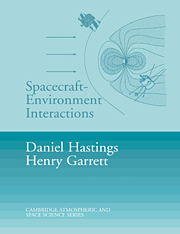Book contents
- Frontmatter
- Contents
- List of Illustrations
- List of Tables
- Preface
- Acknowledgment
- 1 Introduction
- 2 Fundamental Length, Time, and Velocity Scales
- 3 The Ambient Space Environment
- 4 Neutral Gas Interactions
- 5 Plasma Interactions
- 6 The Space Radiation Environment
- 7 Particulate Interactions
- 8 The State of the Art
- References
- Index
8 - The State of the Art
Published online by Cambridge University Press: 30 September 2009
- Frontmatter
- Contents
- List of Illustrations
- List of Tables
- Preface
- Acknowledgment
- 1 Introduction
- 2 Fundamental Length, Time, and Velocity Scales
- 3 The Ambient Space Environment
- 4 Neutral Gas Interactions
- 5 Plasma Interactions
- 6 The Space Radiation Environment
- 7 Particulate Interactions
- 8 The State of the Art
- References
- Index
Summary
Review of the Intellectual State of the Art
In this book, the concepts and theories behind spacecraft–environment interactions were examined. Each chapter is illustrated with selected examples. On the basis of these examples and theories, a reader should be able to identify and construct simple, first-order estimates of the principal interactions of importance to a specific spacecraft. The discipline of spacecraft–environment interactions represented by this process is, however, continuing to evolve both in its intellectual underpinnings and in its value to the spacecraft designer. In this final chapter, the current state of the art in spacecraft–environment interactions is reviewed and the future direction of progress in the field is predicted.
Neutrals
The primary interaction concerns for the neutral atmosphere are drag, atomic oxygen erosion, glow, and contamination. Although the overall processes associated with spacecraft drag in LEO or polar orbits are reasonably well understood, the detailed effects are often hard to predict accurately. The neutral environment for the Earth and its reaction to the Sun are, in principle, moderately well understood. Indeed, statistical models have been built that offer reasonable accuracy. However, there are still outstanding questions to be answered as to how solar and geophysical activity couple to the atmosphere and how to model the often almost impulsive atmospheric responses to sudden changes in these parameters. Errors as high as factors of 10 to 100 in predicting the density along an orbit are not unusual. Once the neutrals strike the spacecraft surface, the accommodation of the neutrals on the surface becomes an issue.
- Type
- Chapter
- Information
- Spacecraft-Environment Interactions , pp. 271 - 280Publisher: Cambridge University PressPrint publication year: 1996



